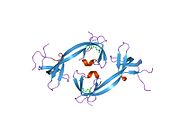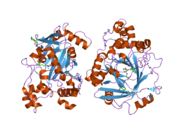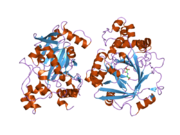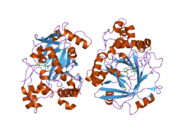Biology:KDM4A
 Generic protein structure example |
Lysine-specific demethylase 4A is an enzyme that in humans is encoded by the KDM4A gene.[1][2][3]
Function
This gene is a member of the Jumonji domain 2 (JMJD2) family and encodes a protein with a JmjN domain, a JmjC domain, a JD2H domain, two TUDOR domains, and two PHD-type zinc fingers. This nuclear protein belongs to the alpha-ketoglutarate-dependent hydroxylase superfamily. It functions as a trimethylation-specific demethylase, converting specific trimethylated histone on histone H3 lysine 9 and 36 residues to the dimethylated form and lysine 9 dimethylated residues to monomethyl, and as a transcriptional repressor.[3]
Alterations in this gene have been found associated with chromosomal instability that leads to cancer.[4]
In humans, the role of Kdm4a as an oncogene, or cancer associated gene, is well established. It is implicated in prostate tumors, where it is overexpressed,[5] and stimulates cell proliferation in colon cancer cells, where it promotes formation of the tumor itself.[6] In lung cancer cell lines, where Kdm4a is also overexpressed, it coordinates with other oncogenes (like Ras) to transform normal cells into cancerous cells by inhibiting tumor suppressor pathways such as p53.[7] Suppression of Kdm4a in breast cancer cell lines has shown to reduce cancer cell proliferation through cell cycle arrest, and decrease tumor migration and invasion.[8]
In mice models, Kdm4a influences various processes leading up to implantation of the embryo.[9] The expression of this gene is observed in all tissues critical to the female reproductive system, including the hypothalamus, pituitary, ovary, oviducts, and uterus, as well as embryonic development. A knockout of this gene in female mice has shown to negatively interfere with maintaining a maternal uterine environment suitable to receive and implant the blastocyst. It also interferes in the early embryonic development of the female mice's pups prior to implantation, leading to infertility. While mechanisms of normal ovulation and fertilization remain unaffected, infertility may also be partly due to decreased levels of Prolactin, a hormone crucial during the process of pregnancy. A knockout of Kdm4a has no effect on the fertility or viability of male pups.[9]
References
- ↑ "Prediction of the coding sequences of unidentified human genes. X. The complete sequences of 100 new cDNA clones from brain which can code for large proteins in vitro". DNA Research 5 (3): 169–76. June 1998. doi:10.1093/dnares/5.3.169. PMID 9734811.
- ↑ "Identification and characterization of JMJD2 family genes in silico". International Journal of Oncology 24 (6): 1623–8. June 2004. doi:10.3892/ijo.25.3.759. PMID 15138608.
- ↑ 3.0 3.1 "Entrez Gene: JMJD2A jumonji domain containing 2A". https://www.ncbi.nlm.nih.gov/sites/entrez?Db=gene&Cmd=ShowDetailView&TermToSearch=9682.
- ↑ "KDM4A lysine demethylase induces site-specific copy gain and rereplication of regions amplified in tumors". Cell 154 (3): 541–55. 2013. doi:10.1016/j.cell.2013.06.051. PMID 23871696.
- ↑ Cloos, Paul A; Christensen, Jesper; Agger, Karl; Maiolica, Alessio; Rappsilber, Juri; Torben, Antal; Hansen, Klaus H; Helin, Kristian (28 May 2006). "The putative oncogene GASC1 demethylates tri- and dimethylated lysine 9 on histone H3". Nature 442 (2006): 307–311. doi:10.1038/nature04837. PMID 16732293. Bibcode: 2006Natur.442..307C.
- ↑ Kim, Tae‐Dong; Shin, Sook; Berry, William L.; Oh, Sangphil; Janknecht, Ralf (1 December 2011). "The JMJD2A demethylase regulates apoptosis and proliferation in colon cancer cells". Journal of Cellular Biochemistry 113 (4): 1368–1376. doi:10.1002/jcb.24009. PMID 22134899.
- ↑ Mallette, Frédérick A.; Richard, Stéphane (November 15, 2012). "JMJD2A Promotes Cellular Transformation by Blocking Cellular Senescence through Transcriptional Repression of the Tumor Suppressor CHD5". Cell Reports 2 (5): 1233–1243. doi:10.1016/j.celrep.2012.09.033. PMID 23168260.
- ↑ Li, Bei-Xu; Zhang, Ming-Chang; Luo, Cheng-Liang; Yang, Peng; Li, Hui; Xu, Hong-Mei; Xu, Hong-Fei; Shen, Yi-Wen et al. (3 Oct 2011). "Effects of RNA interference-mediated gene silencing of JMJD2A on human breast cancer cell line MDA-MB-231 in vitro". Journal of Experimental & Clinical Cancer Research 30 (2011): 90. doi:10.1186/1756-9966-30-90. PMID 21962223.
- ↑ 9.0 9.1 Sankar, Aditya; Kooistra, Susanne Marije; Gonzalez, Javier Martin; Ohlsson, Claes; Poutanen, Matti; Helin, Kristian (2017). "Maternal expression of the histone demethylase Kdm4a is crucial for pre-implantation development". Development 144 (2017): 3264–3277. doi:10.1242/dev.155473. PMID 28827393.
Further reading
- "Normalization and subtraction: two approaches to facilitate gene discovery". Genome Research 6 (9): 791–806. September 1996. doi:10.1101/gr.6.9.791. PMID 8889548.
- "N-CoR mediates DNA methylation-dependent repression through a methyl CpG binding protein Kaiso". Molecular Cell 12 (3): 723–34. September 2003. doi:10.1016/j.molcel.2003.08.008. PMID 14527417.
- "Transcriptome characterization elucidates signaling networks that control human ES cell growth and differentiation". Nature Biotechnology 22 (6): 707–16. June 2004. doi:10.1038/nbt971. PMID 15146197.
- "Sequence comparison of human and mouse genes reveals a homologous block structure in the promoter regions". Genome Research 14 (9): 1711–8. September 2004. doi:10.1101/gr.2435604. PMID 15342556.
- "Functional characterization of JMJD2A, a histone deacetylase- and retinoblastoma-binding protein". The Journal of Biological Chemistry 280 (31): 28507–18. August 2005. doi:10.1074/jbc.M413687200. PMID 15927959.
- "JMJD2A is a novel N-CoR-interacting protein and is involved in repression of the human transcription factor achaete scute-like homologue 2 (ASCL2/Hash2)". Molecular and Cellular Biology 25 (15): 6404–14. August 2005. doi:10.1128/MCB.25.15.6404-6414.2005. PMID 16024779.
- "Quantitative phosphoproteome analysis using a dendrimer conjugation chemistry and tandem mass spectrometry". Nature Methods 2 (8): 591–8. August 2005. doi:10.1038/nmeth776. PMID 16094384.
- "Tudor, MBT and chromo domains gauge the degree of lysine methylation". EMBO Reports 7 (4): 397–403. April 2006. doi:10.1038/sj.embor.7400625. PMID 16415788.
- "Recognition of histone H3 lysine-4 methylation by the double tudor domain of JMJD2A". Science 312 (5774): 748–51. May 2006. doi:10.1126/science.1125162. PMID 16601153. Bibcode: 2006Sci...312..748H.
- "Reversal of histone lysine trimethylation by the JMJD2 family of histone demethylases". Cell 125 (3): 467–81. May 2006. doi:10.1016/j.cell.2006.03.028. PMID 16603238.
- "Structural insights into histone demethylation by JMJD2 family members". Cell 125 (4): 691–702. May 2006. doi:10.1016/j.cell.2006.04.024. PMID 16677698.
- "The transcriptional repressor JHDM3A demethylates trimethyl histone H3 lysine 9 and lysine 36". Nature 442 (7100): 312–6. July 2006. doi:10.1038/nature04853. PMID 16732292. Bibcode: 2006Natur.442..312K.
- "Activation of androgen receptor by histone demethylases JMJD2A and JMJD2D". Biochemical and Biophysical Research Communications 359 (3): 742–6. August 2007. doi:10.1016/j.bbrc.2007.05.179. PMID 17555712.
- "Structural basis of the recognition of a methylated histone tail by JMJD2A". Proceedings of the National Academy of Sciences of the United States of America 104 (26): 10818–23. June 2007. doi:10.1073/pnas.0704525104. PMID 17567753. Bibcode: 2007PNAS..10410818C.
- "Crystal structures of histone demethylase JMJD2A reveal basis for substrate specificity". Nature 448 (7149): 87–91. July 2007. doi:10.1038/nature05971. PMID 17589501. Bibcode: 2007Natur.448...87N.
- "Distinct binding modes specify the recognition of methylated histones H3K4 and H4K20 by JMJD2A-tudor". Nature Structural & Molecular Biology 15 (1): 109–11. January 2008. doi:10.1038/nsmb1326. PMID 18084306.
 |










